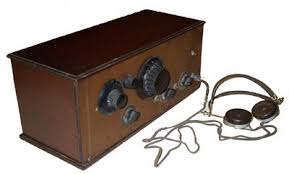Well, owning a portable radio is one of those things you have to achieve before leaving this planet.
Ever since Marconi got fed up with painting his bathroom and decided to invent radio, we have wanted to carry one around with us. “In the old days” say 1930s, sets were nice and big, using valves and components that one would have in a normal table top set, indeed, the same. Two small differences really, one being that some bright spark had screwed a handle on the top and the other you had to have batteries. Now to operate the valves, batteries had to be substantial. You required an accumulator cell (big jam jar, like a small lead acid car battery), giving a couple of volts to drive the valve filaments (to make them hot), a HT battery around 90-120 volts and a smaller battery for Grid Bias. Add to this a big square frame aerial and a speaker. Chuck this in the back of your Austin 7 which could just about manage the weight (women had to ask their husbands to lift the wireless in and out the car because in those days they weren’t very strong you understand) and drive off to your picnic. On a good day, you could find a station to listen to, 2LO or the Home service, for about an hour and a half before the batteries went flat. When you wanted these recharging, you would take them down to your local bicycle shop, where they would have the charging equipment to do such a job. They were set up for charging motorcycle batteries and so, so radio accumulators were a good money spinner.
In the ’50s Mullard created a new range of small 7 pin valves “D” series, which were designed to use little power. Now we had a radio that was portable. Still had to have batteries, 1.5V dry cell for the filaments and a 90V one for the HT. These batteries cost in today’s money about 25€. If you were lucky you could get three or four days use from them and a bit more if you put them in the oven for 20 minutes with the Sunday roast, when they became flat. Most of the sets had a “mains” option. So you could give up the potable idea and leave it indoors. A common design was a mini brief case style with a lid that opened up. As the lid opened, this normally brought the set into life. The lid also housed an aerial. The battery company EveReady made lots of these sets, along with a round weatherproof set made from saucepans, painted in blue Hammerite paint. These were aimed at the African market, were insect, little finger and spear proof.
By the late ’50s and ’60s, transistors were used in portables. Sets were now tiny about the size a large pack of fags, with a little speaker that squawked away, and came with a fake leather carry case. They used a PP3 9V battery which was cheap. Who remembers seeing on the back “Empire Made” and “Made in Hong Kong”? When GB was GB.
A great British company called Roberts made lovely sets. Wooden case, big speaker, tone controls etc. They sounded like the big wireless in the living room. In the late ’60s their chief engineer, Mr. Hacker left Roberts to start his own company and called it Hacker funny enough. No surprise that the resulting sets were solid and perhaps over engineered. Sounded great and worked well. As time went on however, competing with the Far East closed the business. Shame.
By the ’70s and ’80s, most of the UK radio manufacturing had been hived off to China and elsewhere, with just some of the brand names continuing, having been bought by holding companies. Bush, Alba, Murphy and so on. But never fear, we had the Ghetto Blaster, for those with a chip on one shoulder to help keep the balance whilst carrying it on the other.
Now we are left with DAB. Digital Audio Broadcast. Great if you want 100 channels of scratchy intermittent reception. I won’t go on.



